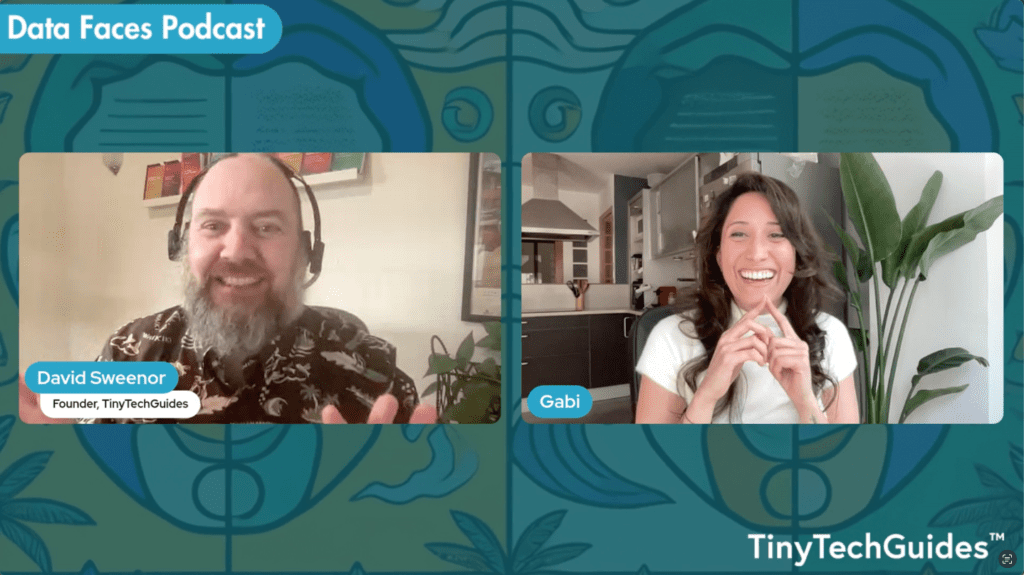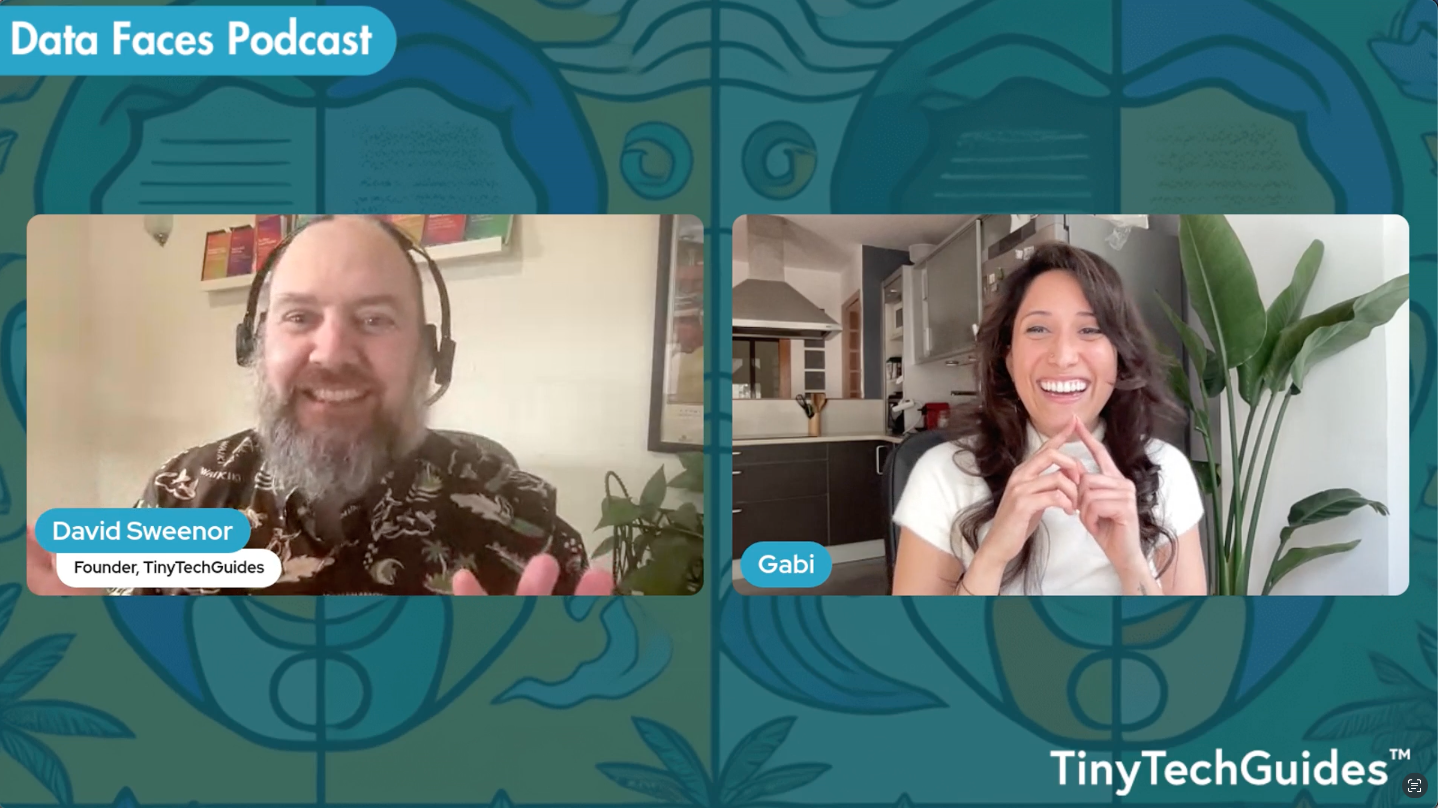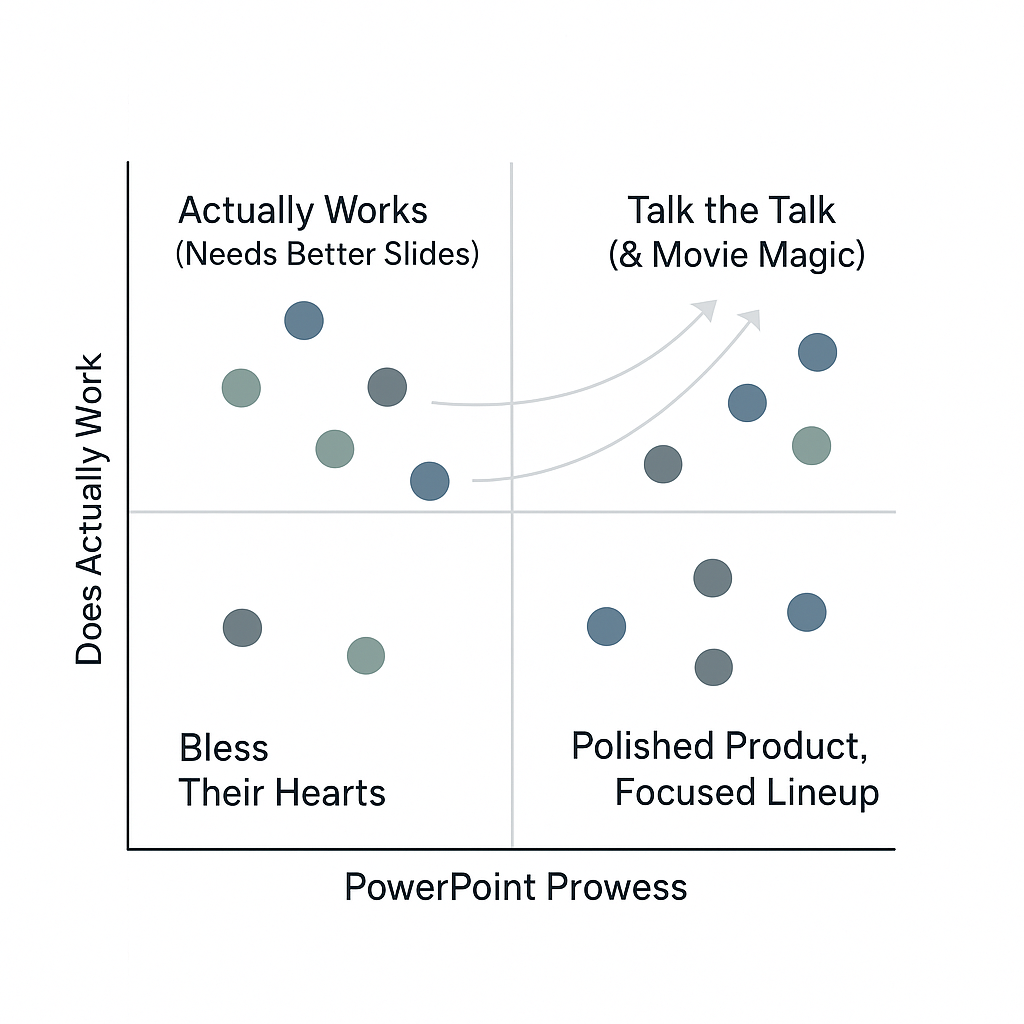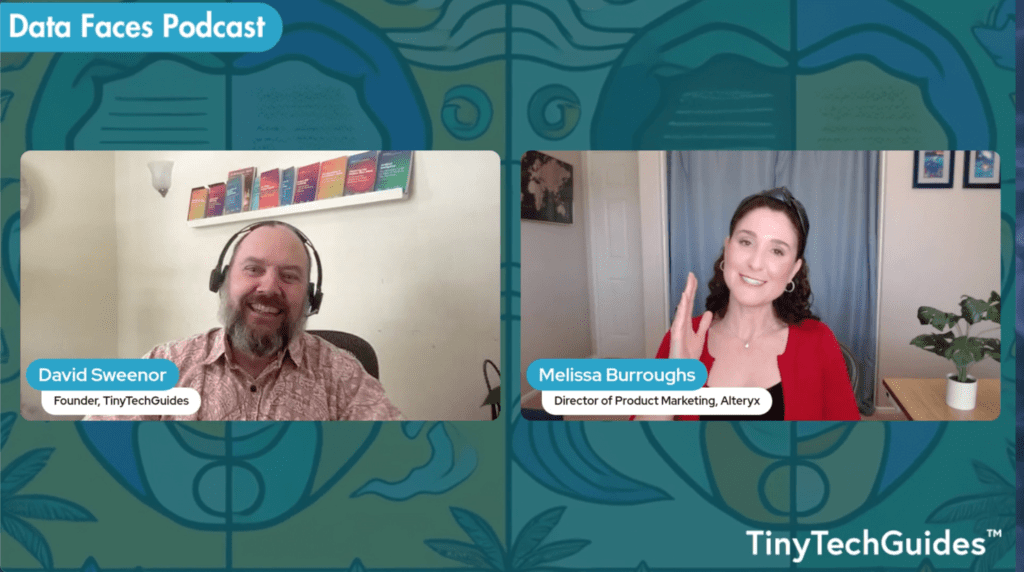Gabriela Contreras on ruthless audience prioritization, escaping jargon land, and making customers the center of your product story
Listen now on YouTube | Spotify | Apple Podcasts

Your B2B messaging isn’t working.
I know because I’ve seen it happen more times than I’d like to remember. Companies with solid products struggle to articulate why anyone should care. In a market packed with 30,000+ software companies, all claiming to be “innovative” and “flexible,” most messaging blends into background noise.
I recently spoke with Gabriela Contreras, who’s built her career solving exactly this problem. As a product marketing consultant with nearly a decade in B2B SaaS, she’s seen what works and what falls flat when companies try to explain their value.
About Gabriela Contreras
Gabriela is the founder of Skyline Marketing, where she focuses on helping startups better position themselves and tell product stories that resonate with buyers. With 8-10 years in B2B SaaS marketing communications, she specializes in helping companies escape “jargon land” to speak about their products in simple, human terms. Gabriela also partners with Emma Stratton to help marketing teams develop new techniques for writing better messaging. In our conversation, we discuss:
- The #1 messaging mistake B2B companies make
- How to navigate messaging for multiple stakeholders
- Techniques for differentiating in saturated markets
- The framework for translating technical features into customer benefits
- How to gain alignment across teams with conflicting needs
- Why your product isn’t the hero (and who is)
It’s such a saturated space, like we all know this, and we feel it as marketers.”- Gabriela Contreras
In this article, I’ll share the insights from our conversation about why your messaging might be falling flat and practical steps to fix it. You’ll walk away with frameworks for targeting the right audiences, techniques for standing out, methods for translating technical features into customer benefits, and approaches for evolving your messaging as markets mature.
The #1 messaging mistake: trying to speak to everyone
The biggest problem Gabriela sees repeatedly? Companies trying to be everything to everyone.
This usually happens after a round of funding or hitting a growth stage. A company finds initial success with a specific audience, then decides it’s time to expand. Suddenly, marketing teams are tasked with speaking to multiple personas with different pain points – and the messaging turns to mush.
The biggest mistake that I keep seeing over and over again is just positioning to everyone… unfortunately, that doesn’t really help to shape a very clear story or clear narrative. – Gabriela Contreras
She pointed to Segment as a perfect example. The customer data routing platform started trying to simultaneously speak to developers, product managers, ecommerce managers, and marketers. Their message became so diluted that more focused competitors like Amplitude and Mixpanel gained the upper hand with targeted audiences.
The fix isn’t complicated, but it requires discipline. Gabriela calls it “ruthless narrowing and prioritization.” Instead of asking “how can we appeal to everyone?” ask “which specific audiences are most likely to need our solution right now?”
Ask yourself:
- Which customers get the most immediate value from what we offer?
- Which personas will raise their hands fastest for this solution?
- How can we speak directly to their specific problems?
When you try to cram different value propositions for multiple personas into one message, you end up with generic statements that resonate with nobody. Focus on your most promising audience segment first, then expand gradually with targeted messaging for each new group.
Navigating the B2B buying committee
B2B purchases rarely involve just one decision maker. You’ve got the executive signing the check, the users who’ll actually work with your product, and often IT gatekeepers evaluating security and integration.
So how do you speak to all these stakeholders without watering down your message?
It’s about understanding where you’re speaking to these different people, and that can help you narrow down the formats and who to focus your messaging on. – Gabriela Contreras
Gabriela recommends mapping your messaging to the customer journey. Different stakeholders enter the conversation at different points, and your materials should reflect this reality.
Here’s a practical approach:
- Partner with your customer success team to identify when different stakeholders typically enter the conversation
- Create targeted content for each role at their entry point:
- Blog posts for early-stage research by analysts
- Email campaigns for middle managers exploring options
- One-pagers addressing specific concerns for executive decision makers
- Track which materials resonate at each stage and with each persona
For example, if customer experience leaders typically sign off on purchases but ecommerce managers and analysts influence the decision, don’t try to address all three in one generic pitch. Tailor your message while maintaining consistency in your core value proposition.
This isn’t about creating entirely different stories – it’s about emphasizing the aspects of your solution that matter most to each stakeholder.
For larger organizations with many customer conversations, conversation intelligence tools can help scale your understanding of what questions and concerns arise with different stakeholders.
Quick check: How many different personas are you trying to address with a single piece of content? If it’s more than two, you’re probably diluting your message.
Breaking through the messaging noise
Let’s face it: most B2B software messaging sounds identical.
Open. Flexible. Scalable. Lower risk. Faster implementation. Sound familiar? With thousands of companies selling similar capabilities, generic messaging just doesn’t cut through anymore.
So what do you do when technical differences between products are increasingly narrow?
If you’re not letting customers do the talking, that’s when your messaging starts to go into jargon land, because you’re losing that connection into what customers are really saying. – Gabriela Contreras
Stop writing messaging in a conference room. Start listening to your customers.
Gabriela’s recommendation is straightforward: implement a Voice of Customer (VOC) program. This doesn’t require a massive research budget – even regular customer interviews, win/loss discussions, or analyzing support conversations can yield gold.
Three practical VOC approaches:
- Customer interviews – Schedule 15-minute calls with your most enthusiastic users to ask what problems you’ve solved for them
- Win/loss analysis – Talk to both customers who chose you and prospects who went elsewhere
- Pattern mining – Review support tickets, sales calls, and customer emails to identify recurring language and themes
The magic happens when you spot patterns in how actual customers describe your value. These authentic expressions become the foundation of messaging that feels real, not manufactured.
“But what if we can’t use customer names?” Gabriela hears this objection often, especially in regulated industries. Her advice: get creative. Try anonymous interview formats (think documentary-style with obscured identities), “confessions” campaigns, or simply use direct quotes without attribution.
What matters is capturing the authentic language customers use. This helps you escape the generic marketing jargon that makes every B2B company sound identical.
Reality check: If your messaging could be applied to three of your competitors with minimal changes, it’s not distinctive enough.
Bridging the technical-business gap
Most B2B products solve complex technical problems. But leading with technical details rarely works with business buyers.
I’ve seen countless demos where the presenter dives straight into features while executives check their phones under the table. They’re thinking: “What does this actually do for me?”
Gabriela recommends a simple framework to fix this: VBF (Value first, Benefit second, Feature last).
It’s less so ’10x your productivity’ and more about ‘freeing yourself from these annoying, tedious tasks that are slowing you down, and making you spend a million hours jumping from spreadsheet to spreadsheet.’ – Gabriela Contreras
This framework flips the common inside-out messaging approach (starting with features) to an outside-in approach that connects with what buyers actually care about.
How VBF works in practice:
- Feature (the how): “Our platform uses AI-powered automation with custom workflows”
- Benefit (the what): “You can process customer requests without manual intervention”
- Value (the big win): “Your team can focus on strategic work instead of repetitive tasks”
Lead with the value, not the feature.
Gabriela shared a perfect example from her work with a founder who had created advanced NLU models for chat automation. Initially, the founder pitched “proprietary, verticalized AI models” (technical jargon). They shifted to messaging that these solutions were “trained specifically on retail customer issues” and could “resolve problems faster than standard chatbots” (clear value).
Another technique: the “so what” test. Take any generic benefit claim like “increased productivity” and repeatedly ask “so what?” until you uncover the real human benefit.
“Increased productivity” → “So what?” → “Less time on tedious tasks” → “So what?” → “Less frustration and more time for meaningful work” → “So what?” → “Greater job satisfaction and career growth”
Now you’re talking about something people actually care about.
Think of your messaging as having different “altitudes” – when talking to a developer, you might fly low with technical details. For a CFO, you need to soar higher with business outcomes. Adjust your altitude based on who you’re speaking to.
Gaining cross-functional alignment
You’ve crafted the perfect messaging. Marketing loves it. Your CEO signs off. Then sales ignores it completely.
Sound familiar?
Marketing teams struggle to align messaging across departments for good reason. Product teams want technical precision. Marketing aims for market differentiation. Sales needs something simple they can actually remember in client meetings.
If you don’t have people involved in the initial conversations, then there’s no way you’ll have that alignment across the board. – Gabriela Contreras
Gabriela shared a story that might hit close to home: a sales executive who “went rogue” and created his own pitch materials because he wasn’t bought into the official messaging. While this might seem like insubordination, it reveals a deeper issue – he wasn’t involved in creating the messaging in the first place.
Her two-step approach to preventing this:
- Start with involvement, not approval Get key stakeholders from each department in the room during initial messaging discussions – not just at the final review stage. Find at least one champion from each team who can represent their department’s perspective.
- Align on what before how Get agreement on positioning and core value before debating specific wording. Make sure everyone agrees on the fundamental story you’re telling before wordsmithing begins.
This doesn’t mean you need consensus on every word choice. For sales enablement, Gabriela recommends providing templates and guidelines while allowing flexibility in delivery. The goal isn’t policing every presentation but ensuring everyone understands the strategic direction.
Think of it like improvisation within a structure – sales teams need room to adapt to customer conversations while maintaining the core themes and differentiators.
Warning sign: If your sales team is creating their own materials from scratch rather than adapting yours, your messaging has already failed the relevance test.
Evolving your messaging as markets mature
Markets change fast. The messaging that worked last year probably won’t work next year.
Gabriela described how contact center AI messaging needed to transform completely over just a 6-7 year period. When the technology was new, messaging focused on technical innovation and basic capabilities. As competitors flooded in (including giants like Zoom and Amazon), the messaging had to evolve to highlight specific differentiation.
As companies evolve, sometimes the messaging stays in ‘how we’re solving the market problem,’ and it doesn’t shift as much into ‘this is how we’re solving the market problem differently from everyone else.’ – Gabriela Contreras
The problem? Most companies get stuck in their original messaging even as the market shifts around them. They keep explaining how they solve a problem long after buyers understand the basic concept and are looking for specific differences between vendors.
You need to watch for these warning signs that your messaging needs updating:
- New competitors enter with similar capabilities
- Your “innovative” features start appearing in competitor products
- Buyers begin asking more sophisticated comparison questions
- Sales cycles lengthen as differentiation becomes unclear
When you spot these signals, it’s time to shift your messaging from “here’s how we solve the problem” to “here’s how we solve it differently from everyone else.”
This isn’t just about watching competitors. You need systematic market intelligence – tracking changes in technology, shifts in buyer priorities, and evolving customer needs.
Customer stories become increasingly valuable as markets mature. They provide specific, credible examples of your unique approach. Generic claims about “efficiency” won’t cut it anymore – you need concrete examples of how Company X achieved specific outcomes that weren’t possible with alternative solutions.
Question to ask yourself: If a prospect looked at your messaging and three competitors’ messaging side by side, would they clearly understand what makes you different?
Your product is not the hero, your customer is
Product marketers fall in love with their products. It’s natural.
I’ve been there – getting excited about a new feature, obsessing over technical capabilities, and trying to cram every innovative detail into my messaging. But here’s the hard truth I learned: nobody cares about your product as much as you do.
Gabriela’s most powerful reminder cuts straight to this point:
Your product is not the hero. Your customer is… How is that helping your customer be the hero in their organization? How is that helping them get their next promotion? How is that helping them look good in front of their boss? – Gabriela Contreras
This mindset shift transforms messaging completely. Instead of droning on about your amazing technology, focus on how that technology helps real people succeed.
When crafting messaging for any feature, ask yourself:
- How does this help someone get recognized at work?
- How does this make them look smart to leadership?
- How does this advance their personal career goals?
I’ve seen the difference this approach makes. When a customer success platform shifted messaging from “AI-powered analytics” to “helps you identify at-risk accounts before they churn,” engagement skyrocketed. Same product, different framing.
This approach naturally bridges technical and emotional benefits. You’re no longer competing on features alone but on your understanding of customer aspirations. The companies that win don’t just build better products – they tell better stories about how those products make their customers successful.
Try this exercise: Take your current product description and rewrite it focusing exclusively on what your customer becomes capable of after using it. Does it feel more compelling?
I’ll revise the final section with a different name than “conclusion.”
Making your messaging matter – Revised
Creating B2B messaging that actually works isn’t about clever wordplay. It’s about truly understanding your audience and speaking directly to what they care about.
The frameworks Gabriela shared offer practical tools for any product marketer struggling with messaging:
- Ruthlessly prioritize your target audiences instead of trying to speak to everyone
- Map different messaging to specific points in the customer journey
- Build a voice of customer program to escape generic marketing language
- Use the VBF framework to translate technical capabilities into real value
- Involve stakeholders early to gain cross-functional alignment
- Evolve your messaging as markets mature
- Make your customer the hero, not your product
Pay attention to warning signs that your messaging needs refreshing: sales teams creating their own materials, lengthening sales cycles, or competitors adopting similar language. In today’s fast-changing technology landscape, messaging must continuously evolve.
As marketers sometimes… we can tend to get a little bit lost in the data, especially as product marketers. Sometimes we think that everything needs to be backed by data. Usually it does, but sometimes you just have to trust your gut. – Gabriela Contreras
And remember Gabriela’s final advice: while data should drive most messaging decisions, sometimes you simply need to trust your marketing instincts. The best messaging combines analytical rigor with authentic human understanding.
Your turn: Take one piece of your current messaging and apply these frameworks. Does it become clearer, more distinctive, and more compelling? If so, you’re on the right track.
About David Sweenor
David Sweenor is an AI, Generative AI, and Product Marketing Expert. He brings this expertise to the forefront as founder of TinyTechGuides and host of the Data Faces podcast. A recognized top 25 analytics thought leader and international speaker, David specializes in practical business applications of artificial intelligence and advanced analytics.
Books
- Artificial Intelligence: An Executive Guide to Make AI Work for Your Business
- Generative AI Business Applications: An Executive Guide with Real-Life Examples and Case Studies
- The Generative AI Practitioner’s Guide: How to Apply LLM Patterns for Enterprise Applications
- The CIO’s Guide to Adopting Generative AI: Five Keys to Success
- Modern B2B Marketing: A Practitioner’s Guide to Marketing Excellence
- The PMM’s Prompt Playbook: Mastering Generative AI for B2B Marketing Success
With over 25 years of hands-on experience implementing AI and analytics solutions, David has supported organizations including Alation, Alteryx, TIBCO, SAS, IBM, Dell, and Quest. His work spans marketing leadership, analytics implementation, and specialized expertise in AI, machine learning, data science, IoT, and business intelligence.
David holds several patents and consistently delivers insights that bridge technical capabilities with business value.
Follow David on Twitter @DavidSweenor and connect with him on LinkedIn.
Podcast Highlights – Timestamps
0:05 – Introduction
David Sweenor introduces the Data Faces podcast and today’s topic: why B2B product marketing messaging isn’t working and how to fix it. Introduces guest Gabriela Contreras of Skyline Marketing.
0:56 – Gabriela’s Background
“I’m founder of Skyline marketing, and really we’re focused on helping startups better position themselves… helping them cut through the noise, tell better product stories that really resonate with buyers, and helping them get away from jargon land and the buzzword land.”
2:16 – The #1 Messaging Mistake
“The biggest mistake that I keep seeing over and over again is just positioning to everyone. You can’t be everything to everyone… So for instance, segment is an example of a company that felt victim to doing this. They were trying to speak to the devs, to the product managers, to the Eco managers, to the marketers.”
4:51 – Navigating Multiple Personas
“It all depends on what are the types of materials that you’re working on… if you know that your buyers are going to be like the customer experience leader, then of course, you need to speak to the person that is going to be signing off on this. But if there are other influencers involved in this deal… it’s important to include messaging for how you’re speaking to them.”
7:13 – Breaking Through the Noise
“There are over 30,000 software companies globally right now… It’s such a saturated space… the best way to combat that is staying close to your customer and having a voice of customer program.”
9:20 – Getting Creative with Customer Evidence
“I worked with a cyber security client who they couldn’t say anything. They couldn’t use their customers’ information, but you can get creative with it. You can take an anonymous interview style, like in the documentaries, where it’s like someone with the distorted voice.”
10:44 – PMMs Accessing Customer Insights
“If you’re able to create good partnership with the customer success team, where maybe there are certain points in the customer journey where you know if a customer meets certain requirements, you can be invited to shadow a call, to shadow a QBR, to join in the last 10 minutes.”
13:42 – Cross-Team Alignment
“Trying to get them in the room when these initial conversations are happening is really important. Not bringing people in at the end, when you’re already presenting what the positioning is going to be… because at that point you’ve already lost them.”
16:25 – Sales Deck Challenges
“Sometimes, I think it’s less about enforcing for the sake of enforcing and just really explaining the why… making sure that it’s something that they can also agree with, and finding a balance there.”
19:24 – Case Study: Translating Technical to Business Value
“When she first started and started building out her initial solution and her platform, the way that she was approaching the problem was really new… but at the same time, it was like, ‘Okay, we’ve got to find a better way to translate the way that you’re talking about your technology.'”
23:18 – The Technical Translation Challenge
“A lot of founders, they bring this energy and this aura, and they’re the only ones that can give the pitch they’re giving, because they have this gravitas about them. So it doesn’t really work for the rest of the organization.”
25:47 – The VBF Rule for Messaging
“I use Emma Stratton’s methodology… applying what’s called the VBF rule to whatever it is that you’re trying to message. It stands for value, first, benefit, second and feature last… from me, the product the company out, instead of outside in, which is taking into account what your buyer really cares about.”
28:39 – Making Messaging Human
“It’s less so ’10x your productivity’ and more about ‘freeing yourself from these annoying, tedious tasks that are slowing you down, and making you spend a million hours jumping from spreadsheet to spreadsheet.'”
31:01 – Evolving Messaging with the Market
“It’s about whether or not you’re evolving with the market… as contact center AI was coming into the scene, what we were doing was really new… But then the market has evolved a lot since then.”35:33 – Final Advice
“Your product is not the hero. Your customer is… how is that helping your customer be the hero in their organization? How is that helping them get their next promotion? How is that helping them look good in front of their boss?”



